Chapter: 11th Food Service Management : Chapter 2 : Basics of Food
Preliminary preparation of food
Preliminary
Preparation
Preliminary preparation of food is very essential to prepare healthy
delicious dishes. The efficiency of a cook depends on how he/she organizes work
in the kitchen. If pre-preparation is thoroughly and systematically done then
the service will be carried out smoothly.
A good chef takes pride in the thoroughness and quality of the pre-
preparation or mise-en -place (pro-nounced meez-on-plahss). This French term
meaning “everything put in place,” has become almost a professional pass-word
in kitchen, because it is important for the success of the establishment.
Pre-preparation saves time and energy. The following steps should be
fol-lowed before the actual cooking.
·
Assemble
tools required.
·
Collect
ingredients needed for cooking
·
Wash,
trim, cut, prepare, and measure raw materials.
·
Check
equipment before cooking.
a. Cleaning/Washing: All raw ingredients should be washed
and cleaned before cooking to ensure microbiological
safety of food. All vegetables should be
washed thor oughly before peeling or cutting. Dry ingredients like
cereals and pulses should be cleaned to remove dirt, stones and foreign matter before cooking.
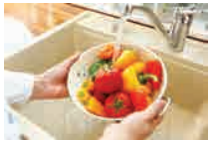
b. Peeling: Most of the vegetables and fruits are peeled before
the preparation of recipe. The outer skin will be peeled using a peeler or
knife. Care should be taken to peel the skin very thin because most of the
nutrients are under the skin of the fruits and vegetables. Certain vegetables
like potatoes can also be peeled after boiling. Tomato skin can be peeled after
blanching.
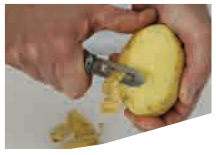
c.
Grinding: Grinding reduces the food to a fine form. Dry grinding helps to get masala
powders and wet grinding helps to get chutneys and batters for idli, dosai and
adai.

d. Grating:
Shredding of certain food-stuffs is called grating. Vegetables and
fruits can be grated to make salads interest-ing. Cheese can be shredded to decorate the foods prepared.

e. Soaking: Foodstuffs are generally soaked to make them soft as it helps to make cooking faster and grinding easier. Cereals and pulses are soaked for grinding and cooking. It enhances nutritional value and helps in removing the toxic substances. It also saves time and fuel.
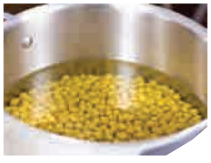
f. Germination: Germination
is the process of a seed to cause sprout or form new
tissue following metabolism. In order to sprout seeds like ragi, green
gram, cow pea and bengal gram soak in water for 8 hours and drain water
and cover it in a muslin cloth and keep it in the room temperature for another
8 hours. Sprouting of seeds can be seen. This process enhances the nutritive
value by increase in vitamin , folic acid and malting of sugar take place.
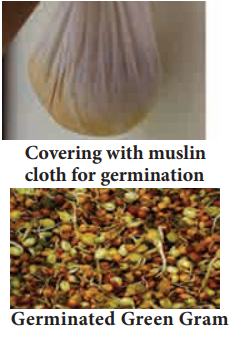
g.
Blanching: Vegetables and fruits are immersed in boiling water for a few min-utes
and then in cold water. This is called blanching. Balancing used infood
preservation as it inactivates the enzymes that cause food spoilage. This
method is also used to loosen the skin of fruits to peel them easily and used
for purees and canned foods.
![]()
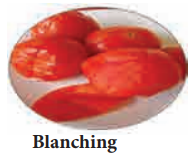
h.
Marinating: Food is soaked in a mari-nade to add flavour and tenderize it. A
marinade is a combination of oil, flavouring agents and acid. Eg: Meat,
fish, and
vegetables
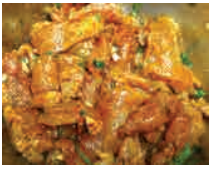
i. Cutting:
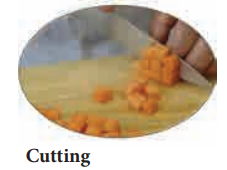
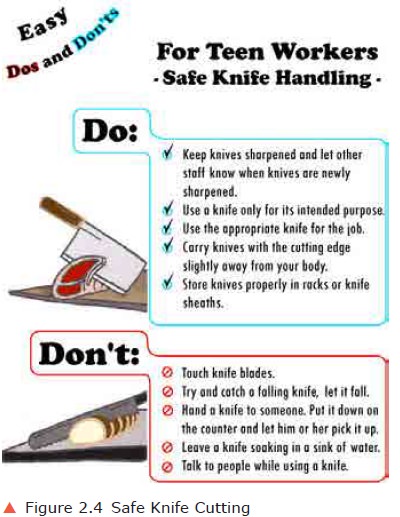
Basic Cuts and Shapes
Cutting food products into
uniform shapes and sizes is important for two reasons:
1.
It ensures
even cooking.
2.
It
enhances the appearance of the product
Common Vegetable Cuts:
·
Brunoise
(broon-wahz); Fine dices (3mm × 3mm × 3mm)
Fine dices are used to make soups, usili and fried rice.
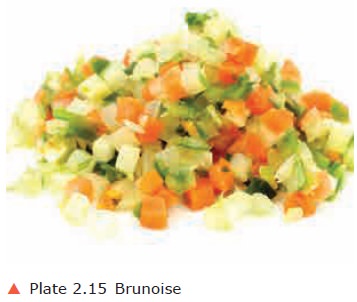
·
Dicing
Small dice: (6mm × 6mm × 6mm)
Medium dice: (12mm × 12mm × 12mm)
Large dice: (2cm × 2cm × 2cm)
Medium dice are mostly used in
the fried items using yam, raw plantain.
Large dice of vegetables are used in the preparation of mourkuzhambu,
sambar.
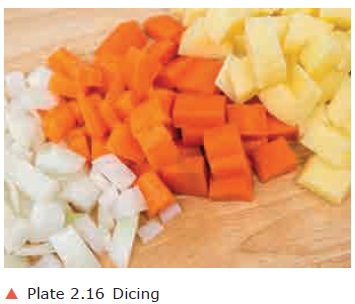
Julienne (or allumette): (3mm × 3mm × 6cm)
Julienne cuts are used in the preparation of salads and noodles

Batonnet: Means little sticks (6mm × 6mm × 6–7.5cm)
Batonnet cuts are used for making
fish fingers.
French fries or pommefrite:
8–12mm sq × 7.5cm long.
The following terms describe
other cut-ting techniques:
·
Chop: to
cut into irregular shaped pieces.
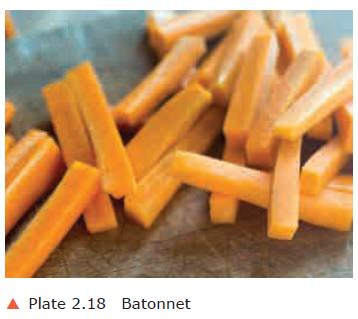
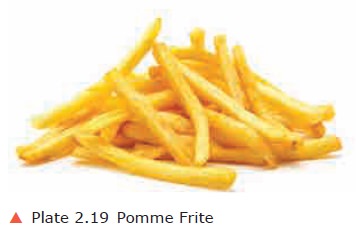
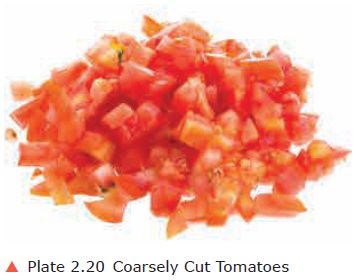
Eg: coriander
leaves chopped to gar-nish dishes.
·
Concasser (con-cass-say): to cut coarsely.
Eg: tomato cuts
for thokku.
Mince: to chop into very fine pieces.
Eg: meat for cutlets.

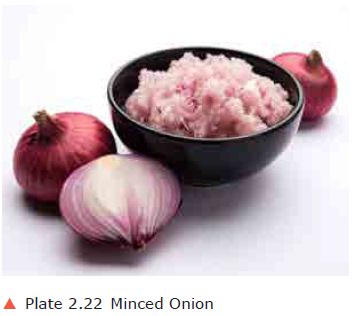
·
Shred: to cut into thin strips, either with the
coarse blade of a grater or with a knife.
Eg: Cheese is shred to top sandwiches and pizzas.
A complete preliminary pro-cedure
is part of the mise-en-place or pre-preparation.
Related Topics